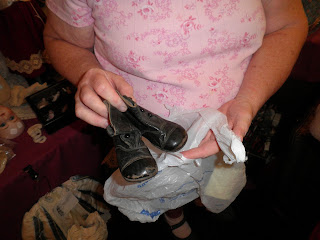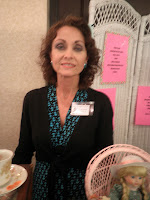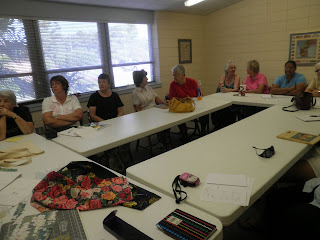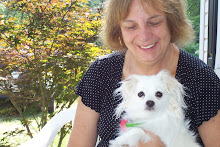September 10th, 2011, I went with a friend Tish to the Pee Dee Doll Club 25th anniversary Doll and Toy Show and Sale at the Ramada Inn in Florence SC.
The show featured more then 20 dealers from across the Southeast with all types of dolls from vintage Barbies, Barbies, Antique Dolls, Collectible Dolls, toys, doll furniture and doll clothes. It was the first doll show I ever attended and I was amazed and fascinated by what I saw. I did buy one small doll and I will show you her later.
Now Tish had come with me in the morning to Columbia to the Creative Cloth Doll Artists Group I belong to because she has a china head doll that she needs to have repaired and hoped to get some information from the women at the group. However when we walked into the Doll and Toy Show and Sale, Tish found what she called the pot of gold at the end of the rainbow.
 |
 |
| This is Tish's China Doll Head |
The doll reminded me of Mary Todd Lincoln and guess what, there is actually a China Doll named after her or really her hair do. Famous people's hairdo's were copied on doll heads.
China head dolls were made by various companies from 1840 to 1940. The vast majority were made in Germany and the doll heads were found on a wood, cloth or kid body. Some had partial limbs made of china as well. Their hair was either a molded hair or a hair wig over a solid bald dome. These Dolls are generally described and identified by their hairstyles since many of the china doll heads are unmarked or may or may not have a mold number. Depending on your dolls hair style, you can approximately judge the era they belonged to.
This is a great site that shows pictures of the different hairdos and eras:
http://dollreference.com/china_head_dolls.html
Tish suffers from the same affliction that I have. I no longer shop for anything unless it has to do with Quilting, Fabric, Dolls, Beads and strange exotic collectibles.
My children have grown to doubt my present choices.
She bought a pair of authentic leather child shoes for her doll.
If you want to know how much they cost, you will have to ask her, however I will say that these shoes did not merit the distinctive packaging of a used grocery bag.
Tish has me in mind for a particular project
 |
She wants me to make the leather hands for her doll. The canvass body not only comes headless, but hand less as well. You can see that the hands are made of leather and are stitched on the outside unlike the dolls hands of cloth dolls today. We have already decided to use kid glove leather maybe even finding vintage gloves. ( I would like to know the difference between vintage and used clothing.) (Angelia Jolie was shown on the Red Carpet wearing a Vintage Gown - Did it come from Goodwill or Bergoff Bygones?)
Anyway back to the hands, How hard can this be? I have made tiny little hands for the cloth dolls, but I know I have been mistaken before, all I have to do is remember the choices I have mistakenly made in men in my life.
 |
| This doll is wearing a fox fur collar stole casually slung over her shoulder. I can just imagine my Omas wearing such a fashion statement. I found fox furs hidden away in the back shelf of a closet and would play with them when I was little. I actually saw one for sale on ebay for $20.00 recently. This doll really caught my eye. Tish told me she is known as a Peddler Doll. Peddler Dolls or "Notion Nannies" were popularly displaced under glass domes in British and American households during the Victorian Era. (My Revlon Bridal doll is displayed in a sideways fish aquarium - It was cheap.) Traditionally dressed in a red cloak and holding a basket overflowing with miniature wares, the peddler doll commemorates the disappearing social custom of itinerant trader's traveling the countryside, the basket containing a tiny world of 18th and early 19th century material culture. As personifications of a village character type similar to the tinkers, they tell a story both sociological and folkloric, In her time the peddler woman was seen as a welcome figure providing a necessary service supporting herself and aiding others through her work. The red cloak has much symbolism attached to it; from fertility to sexuality. They were placed on the mantelpiece for good luck and fortune. She invokes the connections to Little Red Riding Hood, the seemingly endless magic carpet bag of Mary Poppins and Eliza, the little flower girl in My Fair Lady. This information came from the following site, a very difficult one to open: www.bellwethergallery.com/images/artwork/Notion_Nanny.doc Notion Nanny, Tinker, Tailor, Merchant, Maker This is Allison Smith's intrepretation of a Notion Nanny from the above website. 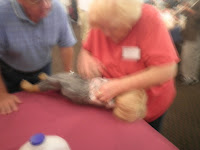  We actually witnessed a doll operation. This doll was valued at over $1500.00. Notice how solicitous the mother is over the impending procedure to her baby. We actually witnessed a doll operation. This doll was valued at over $1500.00. Notice how solicitous the mother is over the impending procedure to her baby. Susan Boyle or Suzanne Hamric another Doll Dealer This baby is a "Reborn Baby" My granddaughters want one of these and have asked me to make them each a baby. It is a little bit daunting to undertake such a task. Finally with all the dolls available this is the one I bought from Dot Smith. It is a Mickey Mouse Club Musketeer Doll. Back in my day. Walt Disney evolved a formula to attract and hold the attention of little and teenage girls. It was Annette Funicello and Tommy. Today its Selema Gomez and Miley Cyrus. So you know what worked before probably works today. http://www.originalmmc.com/ A site devoted to the original Mickey Mouse Club. http://www.youtube.com/watch?v=nOBlXZyKC6A&feature=related Roll call of the mouseketeers. http://www.youtube.com/watch?v=w9DQnT1Awig Mickey Mouse Club March song http://phillipphiles.wordpress.com/2007/10/22/happy-birthday-annette-funicello/ Annette was my favorite Did you watch the original Mickey Mouse Club? |




